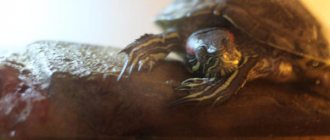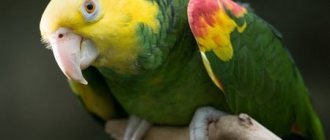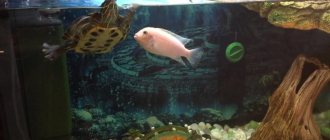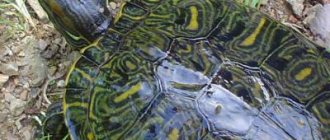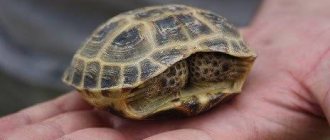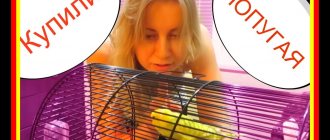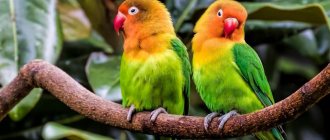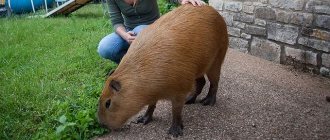The striped raccoon, or American raccoon [1] (lat. Procyon lotor), is a predatory mammal of the raccoon genus of the raccoon family. One of the few species that thrive under conditions of increasing anthropogenic impact, expressed in the gradual cultivation of land[2]. The raccoon takes root well in places of introduction, although it is generally a heat-loving species. On the territory of Russia, the species has well established itself in the western (Black Sea) and eastern (Caspian) regions of the North Caucasus, where it has become a dangerous invasive species that threatens local flora and fauna[3]. In Belarus it has taken root well in Polesie. The raccoon is easily tamed and suitable for breeding in captivity[4].
Distribution[edit | edit code]
The striped raccoon is distributed in North America, from the Isthmus of Panama to the southern provinces of Canada.
Its acclimatization was carried out in Germany and in the territory of the former Soviet Union (most successfully in the south of Belarus and Azerbaijan); From the release points, the raccoon moved to France and other European countries.
In the USSR, raccoon acclimatization was carried out in the 1930s in Primorye, then again in the 1950s and 1980s in a wide strip in the European part of Lithuania, Belarus, Donbass, Ciscaucasia, the Caucasus and Azerbaijan. Animals were also released in Central Asia (Kyrgyzstan) and again in Primorye. In 1936, the North American striped raccoon[5] was acclimatized in the walnut forests of Arslanbob (Kyrgyzstan), where it willingly colonized walnut hollows[6]. The raccoon has also spread widely in the Volga delta[7].
Dagestan[edit | edit code]
The raccoon has well mastered the tugai forests in the Terek and Sulak basins with an area of more than 120 thousand hectares. The beast has successfully developed the lands of the Magaramkent, Derbent and Kayakent regions of the Republic of Dagestan. The Terek-Sulak raccoon population lives in island floodplain forests along the Sulak and Terek with a very small number of large trees. As their numbers increase, the animals also occupy foothill forests. They also fell in love with the subtropical Samur delta.
Krasnodar region[edit | edit code]
In the Western Caucasus, the raccoon has best mastered the forests of the Krasnodar Territory. By the 1970s, the total area of raccoon settlements in the Krasnodar Territory reached 780 thousand hectares. Here, raccoons settled not only in the floodplain forests, but also went quite high into the mountains, for example, in the region of the city of Indyuk. However, the species here demonstrates a pronounced pulsation of numbers and range. Depending on factors such as the season of the year, amount of precipitation, harvest or failure of food, the raccoon migrates from mountainous areas to floodplain, coastal and valley forests, and vice versa. The raccoon has long populated the forests along the left bank of the river. Kuban and the entire Black Sea coast from the city of Novorossiysk - st. Erivanskaya to st. Dakhovskaya - to the village of Bolshoi Kichmay. The species is most well established in the upper reaches of the river. Psekups, along the river valley Pshish and through the forests of almost all mountain rivers flowing into the Black Sea. In some places he also developed the suburbs (Tuapse), parks and forest parks of smaller settlements. Like the gray rat, if it reproduces uncontrolled, a raccoon can turn into a malicious pest of the local fauna and spread diseases in unsanitary conditions of garbage and landfills. But its numbers in the Russian south are limited by another species actively spreading here - the common jackal. In 1967, jackals appeared in the forests of Urup (Penzikov, 1983). In January 1968, the first specimen was killed here. In 1969, 5 animals were killed in the Urupsky region, in 1970 - 6, and in 1971 already 9. The appearance of jackals led to a reduction in the number of hares, and there were almost no introduced raccoons left in the Urupsky region[8].
Tropical raccoons, greetings from Panama
Does a raccoon hibernate where warm weather prevails? – It does, but in rare cases. In regions where the temperature does not drop below +12° (C), raccoons are not prone to winter hibernation. Only a slight decrease in physical activity, which will be noticeable only to an experienced eye, reminds us of the ancient and archaic instinct of hibernation.
Raccoons in this climate zone are light in weight and have light hair. If you put a northern and a tropical raccoon side by side, the difference will be enormous. In fact, the tropical raccoon has become an independent subspecies. These animals are called crustacean raccoons. Unlike the striper, the crayfish has almost smooth fur. It's all about the climate. The tropics are the warmest climate zone. There is no need to protect yourself from the cold with a layer of fat and thick wool.
Winter in the tropics is characterized by heavy rainfall. Do raccoons hibernate during weeks of heavy rain? – Scientists have not observed hibernation. The only thing is that the raccoon can simply wait out the vagaries of nature in its cozy nest. That is, during the rainy season, a raccoon can doze in the hollow of its tree, waiting for good weather.
What about pet raccoons?
Regarding raccoons from northern latitudes, if a pet lives in an outdoor enclosure, it will certainly hibernate. Do raccoons hibernate while living with their owners under the same roof? - No. Living in warm conditions, raccoons are not prone to winter hibernation. The only thing that can remind you of hibernation is a decrease in physical activity.
Source
Lifestyle and nutrition[edit | edit code]
Mixed forests with old hollow trees and the presence of ponds or swamps are most suitable for the striped raccoon. He avoids coniferous forests, as well as forests without bodies of water. In the south of its range it is found on the sea coast. Raccoons easily adapt to the anthropogenic landscape, settling on the outskirts of fields, in gardens, and often in cities and suburbs. The raccoon makes its home (often several) in hollows. As a last resort, it uses ground shelters - crevices in rocks, badger holes; He doesn’t know how to dig holes himself. Leads a twilight-nocturnal lifestyle; spends daytime hours in the den. It goes fishing at dusk, walking around its area (with a radius of up to 1.5 km) in search of food. A raccoon rarely moves more than 1.5 kilometers from its home. In this case, the areas of individual individuals often overlap each other, and, as a result, the density of raccoons in the areas can be quite high[6].
The striped raccoon deftly climbs trees; very tenacious fingers allow it to hang, clinging to a horizontal branch, or go down the trunk upside down. Thanks to excellent night vision and vibrissae, tufts of which are located not only on the head, but also near the claws, on the inside of the limbs, on the chest and stomach, the raccoon can gallop confidently even in complete darkness. The only representative of the raccoon family that goes to sleep for the winter. Sleep is shallow and intermittent. In Canada it lasts 4-5 months; in the southern regions the raccoon often does not fall asleep at all. Sometimes up to 10 individuals gather in large hollows for the winter.
Raccoons of the middle climate zone, greetings from the USA
Animals of mid-latitudes are less prone to winter anabiosis. Do raccoons hibernate? - Yes, they do. But, an amendment needs to be made here. The depth of sleep in raccoons from this climate zone is quite superficial. There are cases when raccoons are walking around the area already in early February. That is, if the weather is sunny and windless outside, the raccoons wake up and go out to warm up.
Of course, in winter the activity of raccoons noticeably decreases. Instead of brawls and hooligan antics, raccoons lead a modest lifestyle, recovering from winter suspended animation. A raccoon that hibernates can sleep for up to 4 months in incomplete suspended animation. That is, any warming wakes up raccoons, which makes sleep shallow and too intermittent. If the winter is warm enough, raccoons may not sleep at all. In this case, hibernation will only be reminded of by a decrease in the physical activity of these animals.
Preparing for hibernation in raccoons from the middle climate zone
This region is home to average raccoons. Unlike their northern counterparts, this family of raccoons does not need to accumulate a protective layer of fat. Of course, raccoons gain weight by winter, but the volume of subcutaneous fat is incomparable with the level of fat deposits of northern raccoons. The same can be said about wool. Raccoon fur is not as thick and fluffy as that of its northern counterparts.
Economic importance[edit | edit code]
The striped raccoon is a valuable fur-bearing animal. The first experiments on its breeding in the USSR were carried out in 1936, in the Caucasus, Central Asia, Belarus and the Far East. In Azerbaijan, the most successful raccoon acclimatization was in the Zakatala-Nukha Valley. The striped raccoon did not take root in the Primorsky Territory, although it existed here from 1937 to 1976[12]. After 1954, 486 raccoons were released in Primorye. But the raccoon dog turned out to be a strong competitor to the raccoon in the fight for local resources. The Far Eastern charza also appears to have been a factor in the failure of raccoon naturalization[6].
In the USA, the raccoon is a commercial species. In North America, under the most optimal conditions, the density of the species reaches 300 individuals per 1000 hectares: then raccoons often destroy fields, orchards, vineyards, melon fields and chicken coops, damaging farms. In Transcaucasia and Dagestan, raccoon density in some areas ranges from 20 to 30 individuals per 1000 hectares.
The animal can also be successfully bred in captivity. Animals with the sign of samson (cotton hair), which is a congenital defect in which matted downy hair is observed due to poorly developed awns, are culled.
Raccoon sleeping at home
If a raccoon lives at home with a person, then it does not need hibernation. The temperature at home is always the same. If he wants to take a nap (instinct will take over), he will fall asleep for a maximum of a couple of weeks.
This can happen in particularly severe frosts, when it can be felt even in a warm apartment. If your raccoon falls asleep, you should never wake him up. The animal's body knows better when to sleep. You can make a “mini house” for a raccoon. Cover it with a blanket ring to make the animal more comfortable. Better yet, don't even touch it.
After a nap, you may notice your pet's slight disorientation. This can be compared to how you feel in the morning. Don't worry, it will go away in an hour or two.
But after such a “mini-hibernation” the raccoon will be active and alert for a long time. The animal stores up its strength and its body, being cleansed, becomes better and stronger. After waking up, the raccoon is usually hungry, so it is worth feeding it.
Classification[edit | edit code]
Currently, there are 22 subspecies of the striped raccoon (Procyon lotor)[13][14], including several island endemics, one of which became extinct in the middle of the 20th century:
- P. lotor auspicatus
- P. lotor elucus
- P. lotor excelsus
- P. lotor fuscipes
- P. lotor gloveralleni – Barbados raccoon†
- P. lotor grinnelli
- P. lotor hernandezii
- P. lotor hirtus
- P. lotor incautus
- P. lotor inesperatus
- P. lotor insularis – Tresmarias raccoon
- P. lotor litoreus
- P. lotor lotor
- P. lotor marinus
- P. lotor maynardi – Bahamian raccoon
- P. lotor megalodous
- P. lotor pacificus
- P. lotor pallidus
- P. lotor psora
- P. lotor pumilus
- P. lotor simus
- P. lotor vancouverensis
Nutrition
The striped raccoon is an omnivore. The search for animal prey is usually concentrated near water bodies. Natural dexterity allows its paws to catch fish, frogs, and small aquatic turtles. The muddy water of the swamps does not prevent successful fishing.
Larger prey includes muskrats, rabbits, squirrels, hamsters, and musk rats. Sharp vision and excellent hearing help the raccoon to be a real predator. The diet contains eggs of birds and reptiles, larvae, insects, earthworms, and small rodents.
Animal food predominates in spring and summer. With the arrival of autumn, preferences change to the plant gifts of nature. Raccoons eat nuts, acorns, mushrooms, various berries, vegetables, fruits, and grain crops. Raids of animals on agricultural land and private farms cause significant damage to owners.
The raccoon has a very sensitive sense of smell, thanks to which it easily finds food
During the spring-summer season, the animal accumulates fat in order to withstand the lack of food with the natural cold at the expense of reserves. They approach human settlements to hunt in places where waste is stored and removed. Raccoons eat food after rinsing in water, sitting on their hind legs.
Notes[edit | edit code]
- ↑ Sokolov V. E. Five-language dictionary of animal names. Mammals. Latin, Russian, English, German, French. / under the general editorship of academician. V. E. Sokolova. – M.: Rus. lang., 1984. – P. 97. – 352 p. – 10,000 copies.
- ↑ Alien species on the territory of Russia: Invasion of alien species: Mammals: Procyon lotor - Raccoon
- ↑ Hunters: raccoons and jackals threaten Sochi | Max Portal
- ↑ Emnr-Onknyaysm
- ↑ Raccoon Raccoon | Natalia Butrina's blog
- ↑ 1 2 3 Library - Rukovsky N.N. - In the footsteps of forest animals - Raccoon Raccoon - St. Petersburg Hunter, website about hunting, forums hunting, weapons, fishing, dogs, cartridges, animals, electronic...
- ↑ Club "Astrakhan Trophy". Raccoon Hunt
- ↑ Jackal Hunting
- ↑ BBC series: Life of Mammals. Episode 6 (inaccessible link). Access date: September 2, 2012. Archived August 3, 2012.
- ↑ Hunting the jackal.
- ↑ enot-doma.ru. How long do Raccoons live? Raccoon at Home.
- ↑ Who are raccoons?
- ↑ Procyon lotor Archived May 21, 2011 on the Wayback Machine in Wilson DE, Reeder DM (editors). 2005. Mammal Species of the World. A Taxonomic and Geographic Reference (3rd ed.). – Baltimore: Johns Hopkins University Press, 2 vols. (2142 pp.) ISBN 978-0-8018-8221-0. OCLC 62265494.
- ↑ Raccoon (English) according to the Integrated Taxonomic Information Service (ITIS).
Which animal does not hibernate?
Some “non-sleeping” animals are actively preparing for winter, building warm homes and collecting food in “pantries”. These include beavers, muskrats and moles. Beavers and muskrats build special insulated huts that protect them from frost, and also stock up on food in the summer.
Interesting materials:
How to check the serial number of a Gucci bag? How to check if a Megacom number is registered? How to print a receipt in Privat24 By number? What are the seat numbers on the bus? How to revive paints by numbers? How to hide your number on Yulia? How to unblock a Beeline number? How to create your own number on Skype? How to enter a number on Instagram? How to see a number in Viber?

